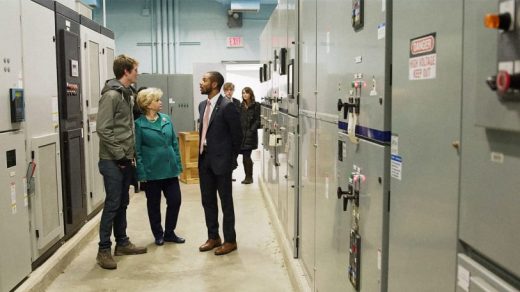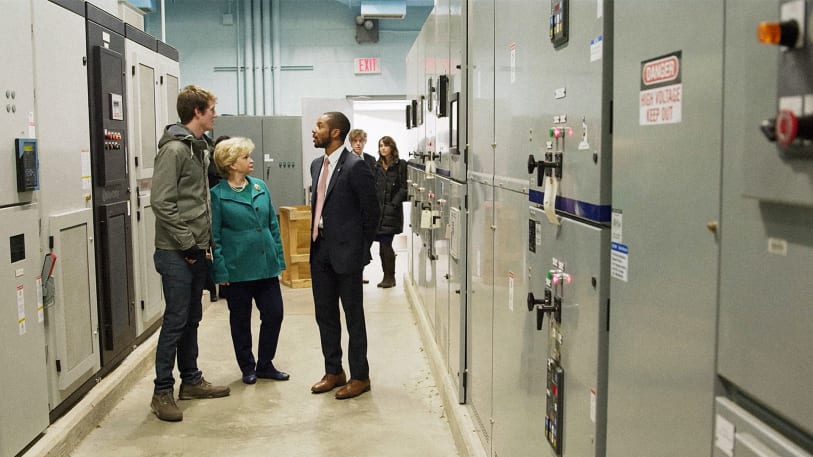The Department Of Energy’s Reality Show Makes Efficiency Fun
It’s not easy to communicate excitement around energy efficiency because it’s all about HVAC upgrades, incremental improvements to boiler systems, and LED lightbulbs. But with the Better Buildings Challenge SWAP–an Apprentice-style energy efficiency face-off in which teams from two organizations try to find wasted energy in the other’s operations–the Department of Energy makes a good show of it. Watching teams of energy professionals nitpick each other’s facilities is surprisingly good viewing, even if the made-for-TV rivalry and portentous voiceover feels too much like The Apprentice at times.
The first installment last year saw Whole Foods take on Hilton Worldwide, before a second pitted the Air Force Academy against the Naval Academy. The latest turns to cities, with Boston taking on Atlanta. Teams from each city visit a range of properties, including airports, libraries, water treatment works, and streets. They find faults in corridor airflows, rhapsodize about rooftop solar panels, and needle each other about phantom light fixtures and the height of heating fans. It’s great fun.
The serious point, says Maria Vargas, head of the Department of Energy’s Better Buildings program, which commissions the web series, is to show how organizations can learn from each other. “Hopefully by seeing real world situations and obstacles, SWAP provides a place for people to learn and feel empowered about making energy efficiencies,” she tells Fast Company. “There’s money investment involved here and people are naturally risk-averse. Seeing other cities do it, and seeing the investments work out, is good information to have.” The first two SWAP series have been viewed about 2 million times on YouTube.
Started by the Obama Administration, the Better Buildings program looks to spread efficiency to the nation’s commercial stock, including offices, schools, and city works. Buildings in total account for at least one third of the nation’s greenhouse gas emissions and in many cases there’s good money to be had from the cost savings earned from efficiency upgrades. The U.S. spends $ 200 billion to operate its commercial property, Vargas says, and frequently older buildings can deliver 20% savings just from doing basic things, like installing better lighting, heating systems, or windows. “A lot of organizations will say they’re energy efficient, but when you probe it a little, you find they’ve done one building or they’ve changed some lights. We’re pushing a deeper, more thorough approach,” she says.
Stephanie Stuckey-Benfield, Atlanta’s chief resilience officer, says appearing in the SWAP helped her learn a few useful things, including how Boston does procurement of energy-efficiency technology. It also made her jealous that Georgia doesn’t have Massachusetts’s regulatory framework, including energy-efficiency targets and a Renewable Energy Portfolio Standard that requires utilities to increase their use of renewables over time. The lack of such measures in Atlanta makes funding projects harder, she says.
“The city of Atlanta is a bit of bubble where we get [energy efficiency]. That’s not the case with the rest of the state necessarily,” she says in an interview. “We still have some climate deniers that we have to grapple with.”
Austin Blackmon, Boston’s chief of environment, energy, and open space, says having outsiders inspect your facilities can reveal “things even in buildings that were renovated not long ago.” Atlanta’s snoopers identified unnecessary lighting in Boston’s library buildings where natural daylight would suffice, for instance.
“With some of the challenges we’re seeing at the national level, it’s more important than ever that cities work together,” he tells me. “Energy efficiency is really difficult to argue against. It’s all about making America more competitive. If we can use energy more efficiently, we can create more jobs and have more resources available for all Americans.”
Vargas says she doesn’t know if Trump’s proposed budget cuts will see the end of SWAP. She hopes to do one more episode before the axe falls, if that’s what happens. Trump’s budget proposal for 2018 calls for a 5.6% cut at the DOE compared to 2017–about $ 1.7 billion. The biggest casualty so far is the Advanced Research Projects Agency-Energy (ARPA-E), an internal technology incubator for early-stage energy projects. Trump has said the private sector should fund such work and research funding may already be tapering off. One SWAP costs about $ 200,000 to produce, Vargas says.
Trump has also issued executive orders culling the Obama Administration’s energy efficiency programs, so perhaps SWAP’s prospects aren’t great. Trump’s attitude to energy in general–including his encomiums to coal–show a man caught in an older time, rather than with the possibilities of doing more work with less power, and producing less pollution while you’re doing it. But then, even if he doesn’t understand the future of energy, Trump does comprehend reality shows. So maybe he’ll tune into SWAP.
(43)



